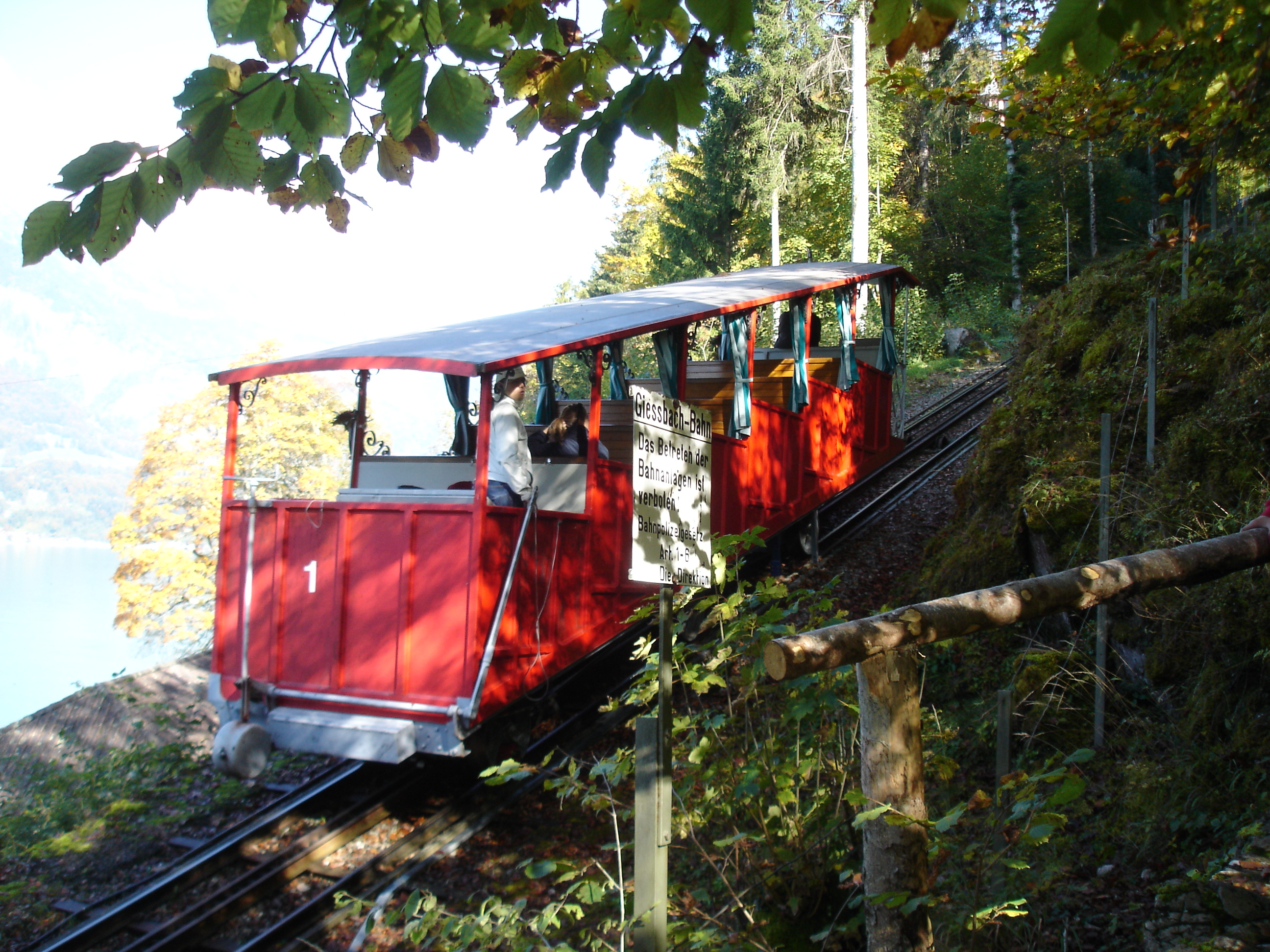Giessbachbahn on:
[Wikipedia]
[Google]
[Amazon]
 The Giessbach Funicular (german: Giessbachbahn) is a historic
The Giessbach Funicular (german: Giessbachbahn) is a historic
Funicular turnout with Abt Switch, first installed at Giessbach 1879, Switzerland
— a slide show by the
Giessbach Bahn page from FunimagGrand Hotel Giessbach web siteThe Giessbachbahn's entry on the Swiss Inventory of Ropeways
{{Coord, 46.7349, 8.0225, display=title Funicular railways in Switzerland Bernese Oberland Former water-powered funicular railways converted to electricity Metre gauge railways in Switzerland Transport in the canton of Bern Railway lines opened in 1879 Heritage railways in Switzerland
 The Giessbach Funicular (german: Giessbachbahn) is a historic
The Giessbach Funicular (german: Giessbachbahn) is a historic funicular
A funicular (, , ) is a type of cable railway system that connects points along a railway track laid on a steep slope. The system is characterized by two counterbalanced carriages (also called cars or trains) permanently attached to opposite en ...
in the Swiss canton of Bern
The canton of Bern or Berne (german: Kanton Bern; rm, Chantun Berna; french: canton de Berne; it, Canton Berna) is one of the 26 cantons forming the Swiss Confederation. Its capital city, Bern, is also the ''de facto'' capital of Switzerland. ...
and municipality of Brienz
Brienz ( , , ) is a village and municipality on the northern shore of Lake Brienz, at the foot of the Brienzer Rothorn mountain, and in the Bernese Oberland region of Switzerland. Besides the village of Brienz, the municipality includes the sett ...
. It links a landing stage on Lake Brienz
Lake Brienz (german: Brienzersee) is a lake just north of the Alps, in the canton of Bern in Switzerland. It has a length of about , a width of and a maximum depth of . Its area is ; the surface is above the sea-level. It is fed, among others, by ...
, served by shipping services on the lake, to the Grand Hotel Giessbach and Giessbach Falls above. The funicular is owned by the hotel, but since 1983 has been operated by a preservation foundation.
Description
The Giessbach funicular was designed by the Swiss engineer Carl Roman Abt. When it was opened in 1879, it was the first funicular with a two-rail single track layout with a relatively short passing loop in the middle. Its turnouts had no moving parts, which was quite a remarkable achievement for the time. Abt had later developed its modification which became known as the ''Abt Switch''. Originally the funicular was powered bywater ballast
Ballast is used in ships to provide moment to resist the lateral forces on the hull. Insufficiently ballasted boats tend to tip or heel excessively in high winds. Too much heel may result in the vessel capsizing. If a sailing vessel needs to vo ...
, and the Riggenbach rack rail in the middle of the track was used for speed control. In 1912 the water ballast system was replaced by a hydraulic engine powered by a Pelton turbine
The Pelton wheel or Pelton Turbine is an impulse-type water turbine invented by American inventor Lester Allan Pelton in the 1870s. The Pelton wheel extracts energy from the impulse of moving water, as opposed to water's dead weight like the tra ...
. Which is in its own turn was replaced in 1948 by an electric drive. The rack rail is currently used for emergency braking. The funicular's two wooden cars are restored back to their original appearance in 1879.
In 2015 the funicular was included in the list of Historic Mechanical Engineering Landmarks by the American Society of Mechanical Engineers under number 259.
Characteristics
The main characteristics of system are:See also
*List of funicular railways
This is a list of funicular railways, organised by place within country and continent. The funiculars range from short urban lines to significant multi-section mountain railways.
A funicular railway is distinguished from the similar incline eleva ...
* List of funiculars in Switzerland
This is a list of all funiculars in Switzerland, commercially operated according to a timetable.
See also
*List of funicular railways
*List of heritage railways and funiculars in Switzerland
*List of aerial tramways in Switzerland
*List of mou ...
* List of heritage railways and funiculars in Switzerland
This is a list of heritage railways in Switzerland. For convenience, the list includes any pre-World War II railway in the large sense of the term (either adhesion railway, rack railway or funicular) currently operated with at least several origi ...
References
External links
Funicular turnout with Abt Switch, first installed at Giessbach 1879, Switzerland
— a slide show by the
ASME
The American Society of Mechanical Engineers (ASME) is an American professional association that, in its own words, "promotes the art, science, and practice of multidisciplinary engineering and allied sciences around the globe" via "continuing ...
with drawings and diagramsGiessbach Bahn page from Funimag
{{Coord, 46.7349, 8.0225, display=title Funicular railways in Switzerland Bernese Oberland Former water-powered funicular railways converted to electricity Metre gauge railways in Switzerland Transport in the canton of Bern Railway lines opened in 1879 Heritage railways in Switzerland